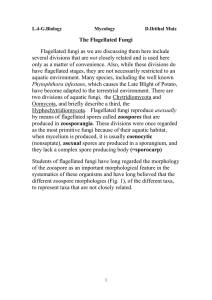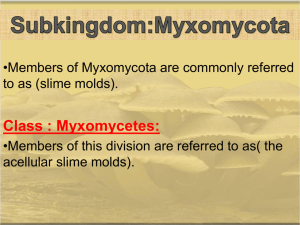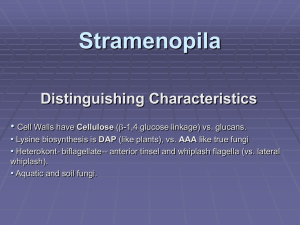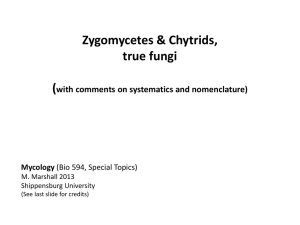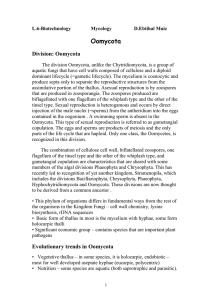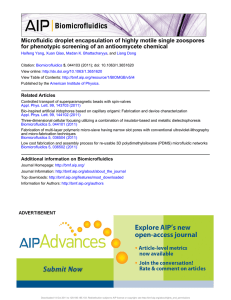eprint_9_24569_561
advertisement
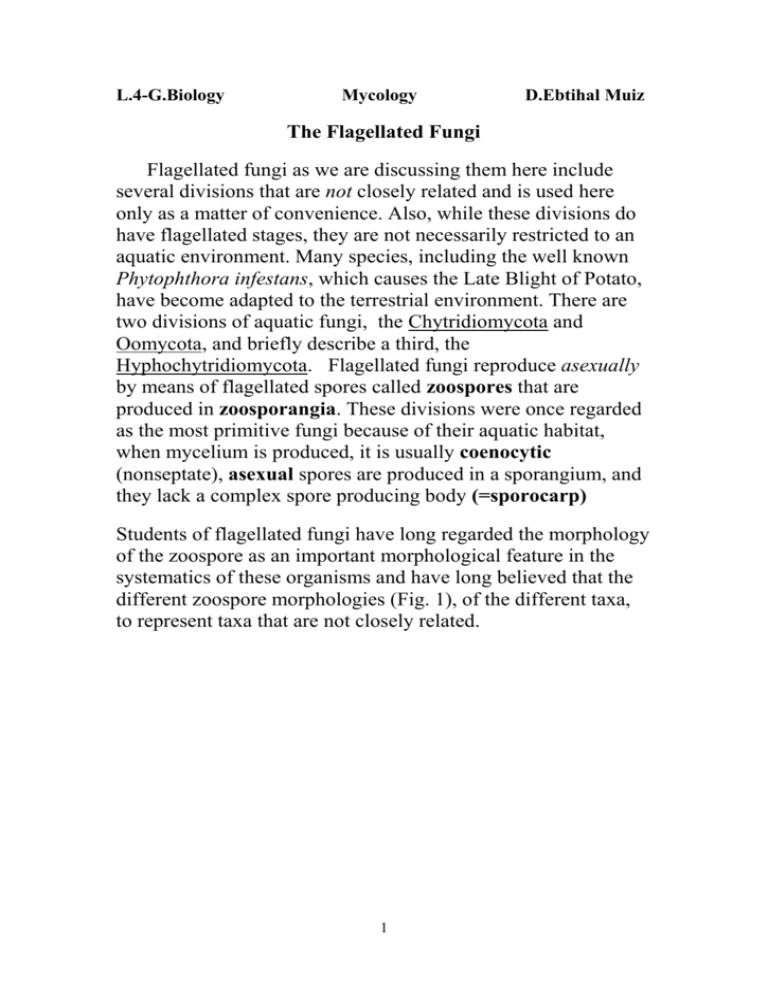
L.4-G.Biology Mycology D.Ebtihal Muiz The Flagellated Fungi Flagellated fungi as we are discussing them here include several divisions that are not closely related and is used here only as a matter of convenience. Also, while these divisions do have flagellated stages, they are not necessarily restricted to an aquatic environment. Many species, including the well known Phytophthora infestans, which causes the Late Blight of Potato, have become adapted to the terrestrial environment. There are two divisions of aquatic fungi, the Chytridiomycota and Oomycota, and briefly describe a third, the Hyphochytridiomycota. Flagellated fungi reproduce asexually by means of flagellated spores called zoospores that are produced in zoosporangia. These divisions were once regarded as the most primitive fungi because of their aquatic habitat, when mycelium is produced, it is usually coenocytic (nonseptate), asexual spores are produced in a sporangium, and they lack a complex spore producing body (=sporocarp) Students of flagellated fungi have long regarded the morphology of the zoospore as an important morphological feature in the systematics of these organisms and have long believed that the different zoospore morphologies (Fig. 1), of the different taxa, to represent taxa that are not closely related. 1 Figure 1A: Zoospore with a single, posterior, whiplash flagellum of Chytridiomycota. 1B: Biflagellated, primary zoospore of Oomycota, with posterior whiplash and tinsel type flagella. 1C: Biflagellated, secondary zoospore of Oomycota, with lateral whiplash and tinsel type flagella. 1D: Anterior, uniflagellate, tinsel type flagellum of Hyphochytridiomycota. The two types of flagella illustrated, above, are whiplash and tinsel type flagella. The whiplash flagellum is unbranched with an acute bend at the end. As flagellar movement propels the cell, the bent end whips back and forth. Thus, the name whiplash. The tinsel type is branched with many mastigonemes, along its axis and resembles the tinsels of an aluminum christmas tree. Results of phylogenetic studies utilizing more recently developed methods, e.g. cell wall biochemistry, ultrastructure and sequencing of the 18S Ribosome, have largely verified the traditional practice of utilizing zoospore morphology as the basis for separating the different taxa of flagellated fungi was a sound one. For many years, fungi, in the strict sense, have been defined according to Margulis and Schwartz (1988): "Heterotrophic, eukaryotic organisms that derive nutrition by absorption, produce aplanospores (=nonmotile spores) on mycelium and/or yeast thalli and have cell walls in their assimilative stage that are composed mostly of chitin". Thus, since flagellated fungi have motile spores, they have all been classified in the kingdom Protista rather than in Myceteae (=Fungi). However, some 2 rather significant changes in our concepts of these fungi have come about since the advent of molecular studies. The following tree, which include organisms that have traditionally been classified as fungi, has been generated based primarily on small subunit robosomal deoxyribonucleic acid (rDNA) sequence analysis: Division: Chytridiomycota Characteristics Chytridiomycota are the smallest and simplest fungi. They emerged soon after the Precambrian period, and are ancestors to all Fungi. The first Chitridiomycota were found in northern Russia. Of the fungi, the share most characteristics with the animal kingdom. At present Chytridiomycota consists of a single class, Chytridioinycetes, containing five orders which are separated on ultrastructural and molecular characteristics. The five orders are Chytridiales, Monoblepharidales, Neocallimastigales, Rhizophydialies and Spizellomycetales. The differences in morphology of the flagellar roots enable separation of 3 isolates down to the level of genus, and are particularly important for determining the order. It has been classified with the true fungi even though flagellated spores and gametes are produced. Gametes and zoospores have a single, posterior whiplash flagellum. Sexual reproduction is variable and may be isogamous, anisogalmous or oogamous. The division has a single class, the Chytridiomycetes. The Thallus Chytrids lack a true mycelium. Each fungus may be in one of three forms. The simplest is monocentric a single holocarpic cell. The monocentric cell may be eucarpic, a single cell with or without rhizoids growing into the substrate. The rhizoids lack nuclei. The fungus may form several sporangia on a single rhizomycelium (cells contain nuclei), and the structure is known as polycentric. Each sporangium may release zoospores of different mating types, and release them at different times. Chytridiomycota have unicellular or mycelial thalli. Cell walls are made of chitin, although one group has walls made of cellulose. Cell growth can be unicellular, or it can occur in the multicellular mycelium of aseptate hyphae. The thallus is typcially unicellular; it may also have limited hyphal growth. It is not considered mycelial. Hyphal cells are coenocytic, although this is not the case where there are reproductive structures. The ultrastructure of the zoospore is a definitve characteristic of Chytridiomycota. In the structure, ribosomes are aggregated around a nuclei that is not enclosed in a nuclear cap. A nuclear cap is an extension of the nuclear membrane. Chytridiomycota have one or two flagella. Nutrition Chytridioinycota feed on both living and decaying organisms. They are heterotrophic. Asexually, Chytridiomycota reproduce through the use of zoospores. In asexual reproduction, zoospores will swim until a desirable substrate is located. The zoospore attaches itself, feeds off its host; the cytoplasm grows, meiotic divisions occur, and a cell wall forms around the original zoospore. Protoplasm increases as the cell continues to develop. Finally, cleavage of the protoplasm occurs, which produces individual Zoospores that are released through a pore. 4 Chytrid life cycle In some species, resting sporangia may take the form of a multicelled, thick walled sorus. The sorus is commonly found within parasitized tissue such as a root, where it remains until the surrounding tissue has rotted away. The resting sporangium may arise from haploid or diploid zoospores. reproduction is haploid dominant. It also depends on the isomorphic alternation of generations. The haploid thallus, called the gametothallus, produces female and male gametes. These occur in pairs and are terminal and sub-terminal. Male gametes are orange-colored, while female gametes are colorless. In addition, female gametes are much larger than male gametes. Males are attracted to females when they produce the hormone sirenin, and females are attracted to males when they produce the hormone parisin. The diploid thallus is called the sporothallus. The sporothallus produces two types of zoosporgia: zoosporgangium (meitosporangium) and resistant sporangium (meiosporangium). Zoosporangia produce diploid zoospores, which can function as a means of asexual reproduction. Sexual reproduction may be isogamous, anisogamous or oogamous. One species, Allomyces macrogynus, has a sporic life cycle, something that occurs in plants but is rare to fungi. A. macroguns is an example of an anisogamous species 5 Members of the division Chytridiomycota have unicellular to mycelial thalli. Their cell wall composition is mostly chitin, and cellulose is not known to occur. Because cell wall composition is thought to be a conservative characteristic, this division was classified by BartnickiGarcia (1970) with the true fungi. However, it was not until studies sequencing of the small subunit rDNA was carried out that mycologist became bold enough to classify this division with the true fungi. Thus, this division has been classified with the true fungi even though flagellated spores and gametes are produced. Gametes and zoospores have a single, posterior whiplash flagellum. Sexual reproduction is variable and may be isogamous, anisogamous or oogamous. The division has a single class, the Chytridiomycetes, We will look at representatives from two orders, the Chytridiales and Blastocladiales. Order: Chytridiales Fungi in this order are commonly referred to as "chytrids". The thallus is commonly unicellular and may have limited hyphal growth, but is not considered to be mycelial. Hyphal cells are coenocytic except where there are reproductive structures. The Chytridiales are thought to be the most primitive members of the Chytridiomycota. A distinctive characteristic of this order can be observed in the ultrastructure of the zoospore. Ribosome is loosely aggregated around the nucle that is not enclosed in a nuclear cap (Fig 1). An example of a simple, unicellular member of this order is Rhizophydium sphaerotheca (Fig. 2), a species commonly found growing on pollen and plant debris. Figure 1: Zoospore of Chytridiales. N=nucleus is surrounded by ribosome (=black dots). The ribosome is loosely associated with the nucleus and is not enclosed within a nuclear cap, which is absent in this order. Zoospore has a single, whiplash flagellum. 6 Figure 2: Rhizophydium sphaerotheca: Four visible zoosporangia growing on a pine pollen (one is out of the plane of focus and is behind one of the more visible sporangia). Zoospores can be seen in two of the three visible zoosporangia. The third has released all of its zoospores. Rhizoids (not visible) anchor the zoosporangia to the substrate. This species is known only to reproduce, asexually. Zoospores released from a zoosporangium will swim for a period of time until a suitable substrate, e.g. pine pollen is located. The zoospore attaches itself by producing rhizoids that will grow into the substrate and anchor it. As the cell feeds on the host, growth of the cytoplasm and numerous mitotic divisions will occur, and a cell wall will form around the original zoospore membrane. The cell wall grows as the protoplasm increases in volume. The enlarged cell becomes the zoosporangium and cleaveage of the protoplasm will produce the individual zoospores that are released through a predetermined pore. Order: Blastocladiales Fungi in this order are more complex than the previous order. True mycelium is produced, which is coenocytic. Zoospores in this order differ from those in the Chytridiales in that the Figure 3: Zoospore characteristic of Blastocladiales. Ribosome around nucleus (=N)is enclosed by an extension of the nuclear membrane, the nuclear cap (=NC). 7 ribosome that is around the nucleus is enclosed around a nuclear cap, which is an extension of the nuclear membrane (Fig 3). We will examine Allomyces macrogynus, a well studied species which has been determined to have a true alternation of generations, i.e. a sporic life cycle, with a multicellular haploid and diploid thallus is produced during its life cycle. This type of life cycle is normally associated with plants and with respect to fungi is only known to occur in this order. The haploid thallus is the gametothallus (=gamete producing thallus), which produces female and male gametangia when mature (Fig. 4). The male and female gametangia occur in pairs and are terminal and subterminal, respectively (Fig. 5). Although not typical, more than a pair of gametangia may occur on each apex of the gametothallus. Male gametes may be distinguished by their orange color, due to carotene pigment, and their smaller size (Fig. 6). Female gametes are colorless and are several times larger than the male (Fig. 6). Thus, this is an example of an anisogamous species. It has long been known that male gametes are attracted to the females by a hormone, sirenin, which is secreted by the female gametes. However, it has recently been demonstrated that a female-attracting hormone is produced by the male (Pommerville, 1990). This hormone has been named parisin. The diploid thallus is the sporothallus (=spore producing thallus) which produces two types of zoosporangia (Fig. 7). One is just called the zoosporangium (=mitosporangium) and the other is the resistant sporangium (=meiosporangium). Both are usually produced terminally 8 but are usually not at the same location. However, clusters of the same type of sporangia may occur. The zoosporangia produces diploid zoospores which germinate to produce more sporothalli. Thus, the diploid zoospore functions as a means of asexual reproduction, and as long as the environment remains favorable for the sporothallus, the zoospores will continue to reproduce in this fashion. Because of the ephemeral habitats in which the aquatic fungi are usually found, eventually the environment of the sporothallus becomes unfavorable and the sporothalli will die. However, the resistant sporangia, which have thick, pigmented walls are resistant to desiccation and will survive after the rest of the thallus dies. When favorable conditions return, meiosis will occur in the resistant sporangia and produce haploid zoospores that will germinate to produce the gametothallus. Figure 4: A young gametothallus on which the female and male gametangia is produced. The thallus is anchored to its substrate by the extensive rhizoids at the base. Figure 5:Terminal branches of mature gametothallus with one male gametangium two female gametangia visible. Note orange color of male gametangium. Figure 6: Male and female gametangia releasing gametes. Note the larger size of female gametes. Thus, gametes are anisogametes. Female and male gametes are attracted to one another by production of the hormones, sirenin and parasin, respectively. 9 10
